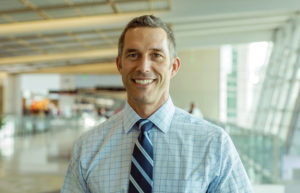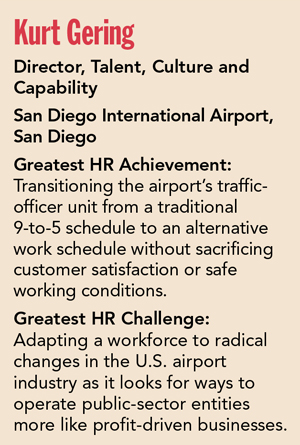This article accompanies Shining Examples.
*
From his office window overlooking the runway at San Diego International Airport, Kurt Gering has a pretty good view of things here in paradise – as he calls it – and we’re not just talking about the incoming and outgoing airplanes.
As the airport’s director of talent, culture and capability since August 2012, Gering keeps a vigilant eye on the moving pieces that keep the entity running smoothly, namely its workforce of approximately 360, many of whom are members of unionized bargaining groups.

And while he still considers himself “brand new” to the airport field, that hasn’t stopped him from implementing new programs and processes aimed at not only maintaining the airport’s high customer-service ratings, but also taking care to address the needs of its workers, which has earned him a spot on HRE’s HR’s Rising Stars list.
Perhaps most emblematic of Gering’s tenure was the rollout of an alternative work schedule after numerous bargaining units began pushing for it, despite hesitancy on behalf of the airport’s leadership team.
HR’s Rising Stars Strategy: Employee Development
To ensure a smooth transition, Gering led a cross-functional team to evaluate the feasibility of implementing both “4/10” (four 10-hour shifts in a seven-day week) and “9/80” (eight nine-hour shifts and one eight-hour shift over two weeks) work schedules and also identified the bargaining unit most likely to pilot the hybrid program: the traffic officers’ unit.
However, from a safety and health perspective, he says, those people are out on the curbs all day. “What would the physical impact be on extending shifts? We did a lot of research on this, including workers’ comp, to make sure we’re not seeing any spikes in claims.”
By all accounts, the rollout has been a success. The new traffic-officer schedule provides greater coverage at the curb for travelers than before, while also maintaining a high customer-satisfaction rate (97 percent) and no work-related injuries of a traffic officer causing loss of work.
 In addition, Gering is currently developing an Internal Semester Abroad program to place employees in rotational assignments in different parts of the organization in order to gain more institutional insight. In his short time there, he’s also managed to knock down the siloes that had been built up around the human resources, training and business-planning elements of the organization and gather them under one newly-named umbrella: the talent, culture and capability department.
In addition, Gering is currently developing an Internal Semester Abroad program to place employees in rotational assignments in different parts of the organization in order to gain more institutional insight. In his short time there, he’s also managed to knock down the siloes that had been built up around the human resources, training and business-planning elements of the organization and gather them under one newly-named umbrella: the talent, culture and capability department.
Gering’s unique educational background (he holds master’s degrees in both education and business administration) may offer some insight into his ability to bridge the divide between workers and management.
In fact, Gering sees many similarities between his current role and his former career as an educator in the Minneapolis Public Schools system.
“As an instructor, I was constantly looking for ways to engage students [mostly underserved youth in Minneapolis]. I had to try and find strategies and ways to engage a diverse audience. That, to me, is a bit [of] what you do in an organization. You have people at various levels of engagement and leadership capacity and you’re trying to figure out strategies to unite them and allow them to give their best.”
HR’s Rising Stars Strategy: Boosting Business Acumen
That mindset proved especially useful after he left behind the cold Midwestern winters for the unwavering warmth of Southern California and took on the position of director of the master of science in executive leadership program at the University of San Diego (while also earning his MBA there).
In his current position, he says, his MBA has helped him “to align with and see what [an organization is] trying to accomplish, and it’s been tremendously helpful and hugely important,” adding that many HR professionals today don’t always connect with their company’s business strategy.
“They see themselves as reactive, simply solving the human-relations issues,” he says. “To me, HR should truly be a business partner, working as a colleague and partner, and, too often we’re coming at it from solely an HR perspective. There are more perspectives than that. I can see the frustration on both sides of the table. And when you can really get that business acumen and see what [the organization] is trying to accomplish, it makes for a fuller picture.”
As a member of the Airports Council International’s North America HR Steering Committee, Gering also sees that the airport industry is going through radical changes, as federal funding dries up, forcing U.S. airports to “find ways to run more like a business” than a not-for-profit enterprise.
To that end, he says, the airport is currently putting into place workforce-planning plans to address what mix of talent and capabilities it will soon need.
“It’s not about replacing people,” he says. “It’s about upscaling them and getting them to change how they think about work.”
Looking ahead, Gering says he sees himself in a CHRO role someday. He says he’s “been clear with my boss that I want to learn.”
That boss, Jeff Lindeman, the airport’s senior director of talent and engagement, notes that Gering should be lauded for his long-view perspective, as well as “his innovative work style, diligent drive and positive presence.”
“Kurt’s big-picture thinking,” he says, “is truly inspiring for people looking to grow in their HR careers.”

